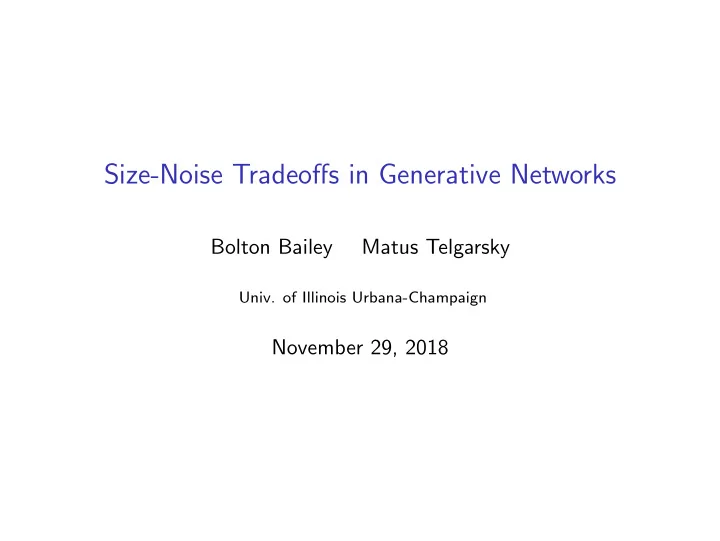

Size-Noise Tradeoffs in Generative Networks Bolton Bailey Matus Telgarsky Univ. of Illinois Urbana-Champaign November 29, 2018
Generative networks Easy distribution X ∈ R n . What can Y be? Hard distribution Y ∈ R d . Generator Network g : X → Y . Previous Work ◮ Universal approximation theorem: Shallow networks approximate continuous functions. ◮ “On the ability of neural nets to express distributions”: Upper bounds for representability & shallow depth separation. Our Contribution: Wasserstein Error Bounds ◮ ( n < d ) Tight error bounds ≈ (Width) Depth → This is a deep lower bound. ◮ ( n = d ) Switching distributions ≈ polylog (1 / Error ). → ◮ ( n > d ) Trivial networks approximate normal by addition.
Increasing Uniform Noise ( n < d = kn ) Networks going from Uniform [0 , 1] n to [0 , 1] kn : � � Depth Optimal Error ≈ (Width) − . k − 1 Upper Bound Proof: Space filling curve. Lower Bound Proof: Affine piece counting. ≈ ≈ ≈ ≈
Normal ↔ Uniform ( n = d = 1) Normal → Uniform: Upper Bound Approximate the normal CDF with Taylor series. + + ≈ → Size = polylog(1 / Error). Uniform → Normal: Upper Bound Approximate the inverse CDF using binary search. Normal CDF Normal CDF Local variables for executing binary search Size = polylog(1 / Error). Lower bounds Size > log(1 / Error) with more affine piece counting.
High Dimensional Uniform to Normal ( n > d ) Summing independent uniform distributions approximates a normal. → → With a version of Berry-Esseen, we have: � Error ≈ 1 / Number of inputs . Poster 10:45 AM - 12:45 PM Room 210 & 230 AB #141
Recommend
More recommend